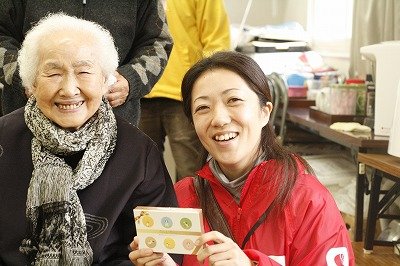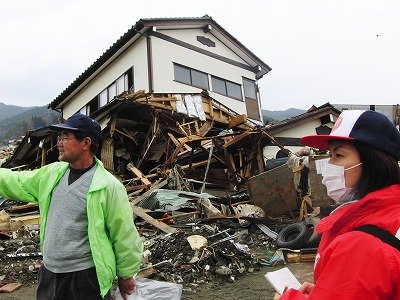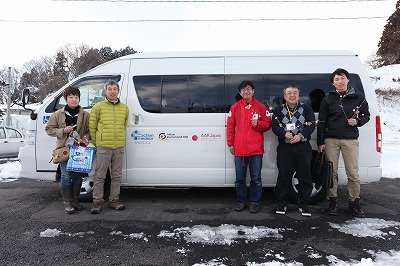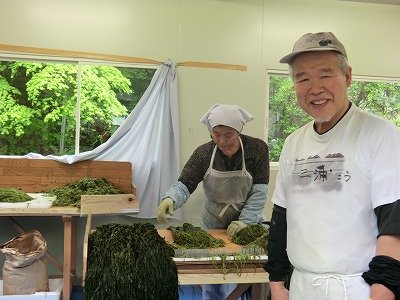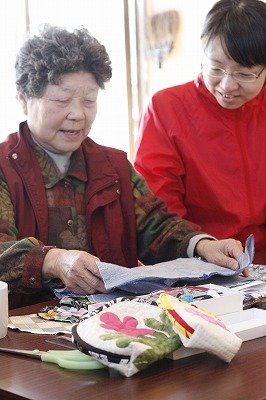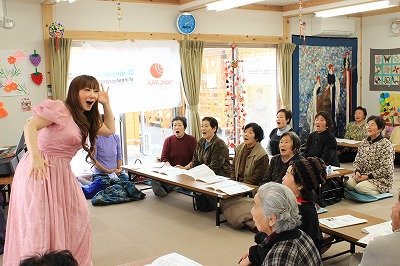By Tomomi AWAMURA | Programme coordinator
Building on its extensive experience in providing international emergency relief, the Association for Aid and Relief, Japan (AAR Japan) has continued its relief activities to support the survivors in the aftermath of the Great East Japan Earthquake. In cooperation with the government and disabled people’s organizations, AAR has utilized its refined mobility as an NGO to continue its relief efforts to those in areas that are difficult to reach. Together with expressing our heart-felt gratitude to the individuals, corporations and organisations that have supported AAR Japan, this report entails our endeavours over the last two years.
2011/3/13
Immediately after the earthquake, our relief team made initial assessments and distributed relief supplies around the disaster stricken areas.
To 180,000 individuals in 1,606 locations
Drawing from our experience in overseas disaster relief that persons with disabilities (PWDs) and the elderly are prone to be overlooked during a disaster, AAR Japan implemented its activities focusing on these two population groups. Adult diapers and retort food were well received at social welfare facilities.
c. Soup Kitchens
25,000 meals in 73 locations
Soup kitchens were organized in our wish to cheer up the disaster survivors with hot meals. Menus were well planned-out so that they were rich in variety and had a fresh taste of the changing seasons.
Recipients of medical check-ups: 817 individuals
Recipients of home-care nurse visit: 387 individuals
AAR Japan organized mobile clinics with a medical team led by Dr. Toshiaki YASUDA, a local medical practitioner, and implemented health-related services including check-ups for chronic illnesses, prevention of infectious diseases, and provision of psychological support through counseling.
In addition to medical check-ups, AAR Japan staff members lent their ears to survivors who carry concerns like their daily worries toward their future and desperate need for supplies. One beneficiary commented, “I was so happy to have people come to my house on multiple occasions and be so concerned about my health condition. Having people recognize my existence gave me strength.”
To 22,599 families
Daily essentials including kitchenware and basic furniture were distributed to all households in temporary and subsidized housing complexes across 13 municipalities in Fukushima Prefecture.
71 locations
AAR Japan conducted reconstruction of facilities for PWDs and senior care centers, and provision of necessary equipment in cooperation with local contractors. This helped the PWDs in disaster areas reunite with their fellow colleagues and resume their former activities and job.
AAR Japan assisted construction of a new bread factory at ‘Hakku no Ie’, a workshop for PWDs in Tanohata Village, Iwate Prefecture. The factory has a dine-in space that serves fresh baked goods and is popular among the local community.
42 vehicles
Assistive and standard vehicles were provided to facilities and local municipal offices throughout the Tohoku region to be used for pick-up and drop-off services for facility users and as a means of transportation for those partaking in recovery efforts.
57 containers provided
AAR Japan provided prefabricated container houses which can be used as both residence and shops.
38 locations
Many facilities for PWDs were damaged by the earthquake. These facilities offered vocational training and employment to those who have difficulty working in private companies; however, as a result of the earthquake disaster, these facilities were lost. By conducting activities such as repairing these facilities for PWDs or supplying the necessary equipment for work, AAR Japan assists PWDs in reclaiming their workplace.
Number of fairs organized: 27
Many workshops have come to restart production of sweets and crafts, however, the sales have decreased at many facilities since existing customers themselves are affected by the disaster. In order to help these facilities explore new sales channels, AAR Japan organizes sales fairs at companies in Tokyo and encourages these facilities to participate in joint fairs held at shopping centers in Morioka and Sendai. We also support the development of new products.
Rehabilitation and active listening: 132 times
Community interaction events: 129 events
In order to help the affected people maintain both their physical and mental health, AAR Japan has organized various events under the title ‘Building Healthy Communities Project’. Events combining programs such as rehabilitation, concerts and active listening are held regularly at temporary housing complexes. We also facilitate farming activities at small-scale gardens in order to promote neighborhood interaction through gardening.
Installment and Provision of Playground Equipment: in 45 locations
Delivery of Bottled Water to Nurseries and Kindergartens: 9 locations/11,440 liters
AAR Japan has assisted in creating play areas where children can relieve their stress and solve the problem of lack of exercise that are developed from living in cramped temporary housing complexes. This includes setting up large-scale playground equipment within the premises of the temporary housing complexes and supplying indoor play toys to places such as assembly halls and day care facilities. Furthermore, in response to the concerns of mothers who are worried about radiation in drinking water, bottles of mineral water are also being provided to preschools in Fukushima Prefecture.
Staff members of AAR Japan’s Soma office continues to visit every residence in temporary housing complexes to carefully listen to the concerns of each resident.
Ekuko Yokoyama, a staff member of Soma office makes rounds every day to talk to those who have confronted loss of family members and face uncertainty about the future.
11 devices delivered
To measure the contamination level of outdoor-grown harvests and food items that they consume daily, radiation dosimeters were installed at support centers of temporary housing complexes and public halls in Soma City.
Hand-made tote bags delivered 10,543 bags
Chocolate 4,843 boxes
Flower seedlings 1,603 pots
In response to suggestions made by the disaster survivors that a tote bag would be useful when going to school or to organize relief supplies that were provided, a large number of handmade bags with messages attached were donated after a nation-wide call out for their creation. (Bags collected in April 2011, October 2011 and September 2012).
Several people also contributed to the “Heart-Warming Chocolate Delivery Campaign” where messages of support from the public were attached to boxes of AAR Japan’s charity chocolate (with cooperation from the Rokkatei Confectionary Co., Ltd.) and delivered to the disaster areas. There were those who shed tears when they received the message, “We have not forgotten about you”. (Messages collected: Winter 2011-2012 and Winter 2012-2013).
In the spring of 2012, AAR Japan commenced the “Delivering Flowers and Magokoro (literally translated as sincerity) Campaign” that aimed to send flowers to brighten up the disaster-stricken areas. Purchasing potted plants from florists and facilities for PWDs in the disaster areas, they were then individually delivered to places such as temporary housing complexes, each with a message attached.
In cooperation with the Morioka City’s municipal office and Morioka Municipal Hospital, AAR Japan implements activities to promote the health of people living in the coastal areas of Iwate and Miyagi prefectures. People living in cramped temporary housing are prone to suffer from lack of exercise that could lead to economy syndrome and disuse syndrome. A medical team makes visits to temporary housing complexes to conduct prevention screening and workshop for exercise to counter these diseases.
5 staff members dispatched for 51 cumulative months
In cooperation with the local government and other organizations, AAR Japan addresses issues surrounding the welfare system for PWDs in the disaster areas. In Iwate Prefecture, 4 staff members were temporarily dispatched to the regional centers of the “Iwate Disability and Welfare Recovery and Relief Center”. Creating manuals for emergency evacuations and gaining a deeper understanding of the actual conditions of the disaster survivors with disabilities are examples of the work that is being conducted. In Miyagi Prefecture, AAR Japan has dispatched one staff member to the “Miyagi Prefecture Ikuseikai”. Focusing on Minami-Sanriku Town, this project has continued with repairs of areas in which children with disabilities can play after school and during the summer holidays.
Help Survivors to Make a New Start
There is still a lot of work to do in the disaster-hit areas of Japan! If you would like to help us provide long-term assistance to the earthquake and tsunami survivors, please consider making a monthly donation to one of the above projects. Every donation (be it one-time or recurring) is truly appreciated.
Thank you for your support!
Sincerely,
Your AAR Japan Project Team
====
Check our other activities on http://www.aarjapan.gr.jp/english/ !
====
By Daijo Tsuchikawa | Programme Coordinator
By Daijo Tsuchikawa | Programme Coordinator
Project reports on GlobalGiving are posted directly to globalgiving.org by Project Leaders as they are completed, generally every 3-4 months. To protect the integrity of these documents, GlobalGiving does not alter them; therefore you may find some language or formatting issues.
If you donate to this project or have donated to this project, you can receive an email when this project posts a report. You can also subscribe for reports without donating.
